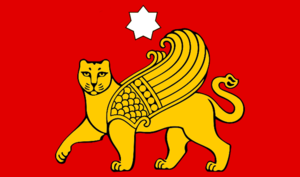Difference between revisions of "Koman people"
| Line 1: | Line 1: | ||
{{Infobox ethnic group | {{Infobox ethnic group | ||
| group = Komans<br>'' | | group = Komans<br>''Qālqāra'' | ||
| image = Flag Komania.png | | image = Flag Komania.png | ||
| caption = Flag of the Komans | | caption = Flag of the Komans | ||
| Line 40: | Line 40: | ||
| related = [[Balak people|Balaks]], [[Mishar people]], [[Gushli people]] | | related = [[Balak people|Balaks]], [[Mishar people]], [[Gushli people]] | ||
}} | }} | ||
'''Komans''' ([[ | '''Komans''' ([[Qālqāra]] IPA: /xɒlxɒrä/ or Qāman, IPA: /xɒmän/) are a [[Vaniuan peoples|Vaniuan]] ethnic group that originally formed in the [[Golden Steppes]] during the 1th–7th centuries, primarily from Eastern Vaniuan and pre-Vaniuan tribes that moved from Northern Vaniu around 100 BCE and came to inhabit the present-day lands of [[Komania]] through several large-scale migrations after the collapse of the [[Kalkali]] nomadic state, with large contributions from former [[pre-Vaniuan]] tribes in the area. | ||
==Language== | ==Language== | ||
Revision as of 21:37, 21 January 2018
 Flag of the Komans | |
| Regions with significant populations | |
|---|---|
| 42,904,651 | |
| 500,000 ≥ | |
| 10,000 | |
| 7,202 | |
| Sotanxina | 13,334 |
| Overseas | 2,000,000 ≥ (disputed) |
| Languages | |
| Koman | |
| Religion | |
| Thaghaism | |
| Related ethnic groups | |
| Balaks, Mishar people, Gushli people | |
Komans (Qālqāra IPA: /xɒlxɒrä/ or Qāman, IPA: /xɒmän/) are a Vaniuan ethnic group that originally formed in the Golden Steppes during the 1th–7th centuries, primarily from Eastern Vaniuan and pre-Vaniuan tribes that moved from Northern Vaniu around 100 BCE and came to inhabit the present-day lands of Komania through several large-scale migrations after the collapse of the Kalkali nomadic state, with large contributions from former pre-Vaniuan tribes in the area.
Language
The Komans speak the Koman language, a member of the Vaniuan family from the Kalkalic (Northeastern) sub-group of Eastern Vaniuan languages, the language itself is distinguished by its total lack of affricates, fusional nature, large substratum of pre-Vaniuan loanwords and having the peculiarity of being conservative, sharing structural similarities with proto-Eastern Vaniuan.
The Koman language has been historically written with a variant of the Vaniuan script known as Shershishe Şērşīşe (lit: black mark, alphabet), developed around 200CE and regarded as having strong influences from pre-Vaniuan logographic scripts, its use declined after the fall of the Great Horde mostly due to efforts to "globalise" the Koman people, being replaced at last with the Vaniuan script around the 18th century through several policies of re-education. Today the language is officially written with the Vaniuan script, although it can be common to see Shershishe scriptures in traditional mōrāms and holy places, with holy books often published with both scripts to maintain a sense of traditionalism. Apart from being the official language of Komania, it is also spoken in different varieties on reduced pockets around the surrounding countries of Balakia, Nekhilia and Gushlia.